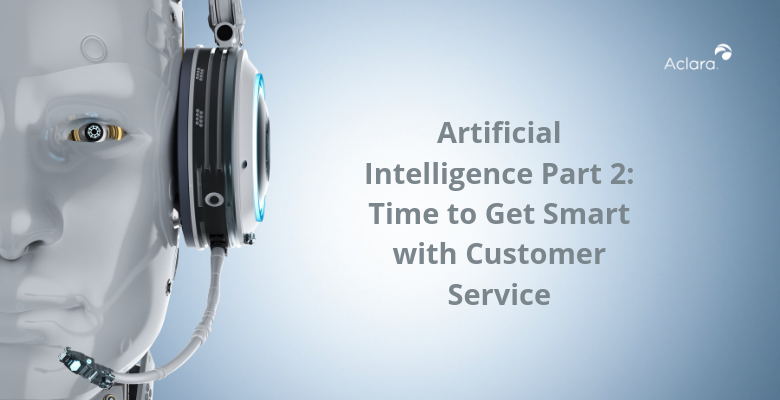In Part 2 of our series on how utilities are using artificial intelligence, we look at how AI helps utilities elevate customer care. Read Part 1 here.
Given the right hardware, a consumer can check who’s at the front door via a smartphone or click an email link to track a delivery. These days, consumers are used to getting knowledge when and where they need it, although in most cases, they can’t get much information from a gas, electricity or water providers. That’s likely to change soon, and artificial intelligence will be a driver of enhanced services for utility customers.
A new way to look at data
A key component for implementing AI in customer service at utilities to disaggregate, or break down, smart meter data into appliance-level insights as a way to infuse more value into the traditional home energy report. Disaggregation parses out the various appliances and other loads that constitute the entire demand of a customer’s premises. Through disaggregation, utilities can identify big loads, like washers and dryers, air conditioners, pool pumps or other large power consumers in the household.
That means utilities could send proactive alerts when something looks off. For instance, a refrigerator with a malfunctioning compressor and leaky seals will use more electricity as it struggles to keep the chill going strong. So will a clothing dryer, and that could add plenty to the old power bill. One Energy Star estimate notes that a clothing dryer can make up as much as 6 percent household electricity expense.
Wouldn’t the average utility customer want to know when appliances are starting to show problems through abnormal electricity consumption? Sure, they would. After all, consumers now get all kinds of helpful alerts these days, and they’re used to it. The household printer warns its owner when ink is running low. A bank may send an email or text to an account holder who buys something from an online vendor outside the U.S. Alerts abound.
Information is ammunition
What’s more, this kind of insight can lend real value for utilities that give customers those comparative usage reports that let people know if they’re using more or less power than similar homes nearby. In the absence of actual, targeted ideas for energy savings, some people question the value of reports.
“The accusation — I mean home energy report — came in the mail the other day,” wrote former Chicago Tribune columnist Barbara Brotman after her utility let her know she’d used 66 percent more power than average neighbors and 88 percent more than the energy-efficient folks.
“How could we possibly be using that much more electricity? Were we lighting our house like night baseball? Heating our house with hair dryers?” she added.
Ms. Brotman may have been less annoyed if her utility had indicated why her energy usage was so high and suggested how she could fix any problems. Using data science methods like disaggregation, utilities can provide the ammunition customers need to act on the power pirates that are in their homes.
If the utility was using artificial intelligence for load disaggregation, perhaps it could have added that handy insight. Wouldn’t it be nice to send customers information on their consumption and ammo to stop the power pirates?
“Using newer data science methods, we might look at a customer’s bill over the range of a few months and say, ‘Your washer and dryer’s 12% of your electric bill versus the average is 8%. You’ve fallen out of range; you should consider looking into that,’” said Frank Brooks, vice-president of product management for software at Aclara.
“We’re not quite at that point, but I think if you look at the way we get data and the way we continue to use data science, I don’t see that as something that’s far from where we are today. We just don’t do it yet,” he added
With the right analytics, electric utilities can offer such helpful alerts and advice. So can gas utilities, for whom analytics identify pressure problems and methane leaks. On the water side, leaks show up too, and soon there will be algorithms in place so that utilities can tell customers whether the leak is a running faucet, a bad flapper valve on a toilet, a busted irrigation pipe or something that’s going to flood the basement.
Saving money for consumers
Ahead, analytics will likely be linked to various loads around the house as well as virtual helpers like Alexa or Google Assistant. According to Brooks, this means a customer will be able to manage the loads in the house automatically, according to a criterion set by the customer.
“Imagine a customer saying, ‘Tell Alexa I want to save $15 on my power bill this month, and I don’t want to have to turn out lights or touch the thermostat to do it.’ Alexa will then make changes to turn up or down the thermostat in the middle of the night, when it’s not likely to bother anyone, run lights with dimmer switches at 80 percent, or turn off the TV between certain hours,” said Brooks.
Artificial intelligence will also allow water and gas utilities to serve their customers better with insights about problems in their homes. For instance, a water utility could look at patterns of usage and suggest whether that leak is a toilet or a constantly running faucet. Similarly, a gas utility could apply algorithms to differentiate between an appliance being left on or a dangerous gas leak.
Consumers are already accustomed to getting specific information related to their buying or browsing habits by companies as diverse as Amazon and Google, with associated suggestions that make that information useful. Artificial intelligence extends that capability to utilities, making that level of service and care a reality for utility customers.



